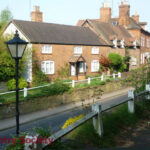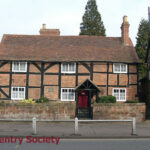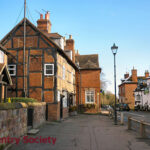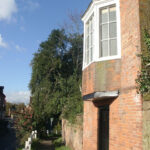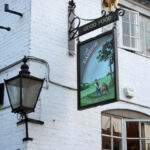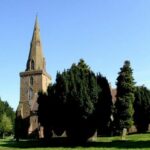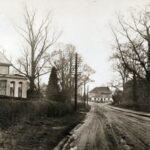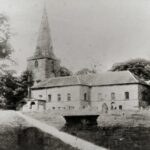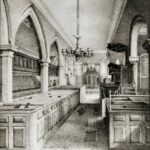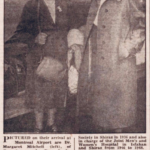Allesley
Homepage » Allesley
Allesley Village
Allesley has a long history, dating back at least to Norman times. There was a Motte and Bailey castle in the grounds of what is now Allesley Hall dating back to the Norman Conquest. The park itself was established as a deer
park in the 13th Century and a manor house was built in 1660. That house was later replaced with a Georgian building, which at one point was used as a boys boarding school. The building was substantially rebuilt by Lord
Illiffe, proprietor of the Coventry Telegraph, at the beginning of the 20th Century and it later became the home of the Council’s Parks Department before becoming its current use as a Care Home.
Allesley Village has changed little from the days when it was a popular lodging and watering place for stage coach travellers en route to Shrewsbury, Chester and Ireland. There were ample stables where horses could be rested
or changed for another team. 1824 saw civil engineer Thomas Telford constructing the Holyhead Road, a direct route from the city centre that by-passed the old road to Allesley. It opened five years later with the level of
the road up to the Rainbow Inn excavated to make it less of a haul for horse drawn carriages. The work created something of a bluff below the churchyard and high retaining walls of stone supported raised footpaths at
the centre of the village.
The old Turnpike House remained open for business at the junction of the old and new roads. Farmers moving cattle through the village often went to great trouble to make wide detours to avoid paying the toll that mounted up
when large numbers of animals were driven through. There’s an old tale that a tinker was asked for a toll on each of each of his donkey’s four hooves as well as the cart, so he lifted the animal into the cart and pulled it
through himself!
Travellers in Telford’s day would pass the fine mansion where the widow of the Rector, the Rev Bree lived (now The Elms). In the 1920s Tom Paybody bought the property and established an eye hospital there. The Paybody
as it was known became an orthopaedic hospital until 1963. Travelling on, glimpses of the Parish Church of All Saints could be seen high above the road. A succession of Brees would be incumbents and owners of property in the
village over several generations.
The gazebo on the pathway up to the church was a popular meeting place for the Rector’s wife and her friends. It served as a sewing room and a perfect lookout to watch the stage coaches as they passed by. On
entering the village itself notable dwellings are the Stonehouse dating from the 16th century and The Lodge, an early Georgian building (circa 1720) at the bottom of Rectory Lane, later to become the home of curates of the
parish.
The Rainbow Inn was a dwelling in the 17th century, becoming an ale house some 100 years later. At the beginning of the 19th century it was owned by the Rector of Allesley, the Reverend Thomas Bree. The Tatlow
family ran the pub in the earlier part of the 20th century with Kate becoming licensee in 1931. Son Jack had played hockey for England and ran the village cricket team. Beyond The Rainbow is Gable End (now part of
the Allesley Hotel), bequeathed to the Reverend William (later Archdeacon) Bree by cousins once removed. The hotel itself has earlier foundations dating to the time of Elizabeth the First. In Telford’s day it was
the home of the curate of Christ Church in Coventry. Post WW2 the hotel has had a varied history. It has been owned by Irish businessman Fred Kilpatrick and for several years was run by the Freemasons.
Lion House and Park House were once one property, licensed premises called The White Lion. While the current structure appears to be late Georgian, it’s undoubtedly the result of re-building. The internal structure is
much older with a Robert Hinckes granted a license to keep an inn there in 1636. There were many rooms and the stables adjacent survive to this day. On the north side of the village street is Arden House, built c1740
on the site of an old forge. It remained a private dwelling until the middle of the 19th century when it became a boarding school, then reverted to being a dwelling by the turn of the century. Next door is the
Barn House, first mentioned early in the 17th century. By 1661 it was owned by one Richard Ebourne who had purchased most of the farmland to the north of the village street. With the barn next door dated 1812 it
was the only farm in the village.
Notables who once lived in Allesley Village: Dr Margaret Mitchell’s home was Arden House. She started her career as a doctor in the casualty department at Coventry and Warwickshire hospital and became a renowned specialist
in the treatment of eye diseases. Dr Michell’s interesting life started at the age of 22 when she was awarded the Croix de Guerre for her services as a volunteer with the Red Cross in France in the WW1. In the 1920s
she answered a call for medical missionaries in India and took up a post in the Himalayan Kingdom of Kashmir when it was under British Crown. Before the start of WW2, she went to Persia to take charge of a mission
hospital. She returned to Allesley and established a first aid post in the village. As President of the Women’s British Legion she organised the local Poppy Appeal for more than 40 years. She took a particular
interest in the Christian Medical Hospital at Vellore in Southern India and for years helped raise funds to support it.
Sir Donald Gibson lived at Lion House while he was Coventry’s first City Architect and Planning Officer (1938-1954). The postwar redevelopment of Coventry city centre following the Coventry Blitz saw the implementation of
The Gibson Plan
– a brand new town planning concept, with the main premise being a separation of motor traffic and pedestrians. The city’s Precinct was the first in Europe.
Sir Edward Newdigate, a son of a former owner of Allesley Hall, lived at Gable End towards the end of the 19th century. He was a professional soldier and reached the rank of Lieutenant General in the Rifle Brigade. He
served in the Crimean and Anglo-Zulu Wars. On retirement from the Army he was appointed Knight Commander of the Order of the Bath and served as Governor of Bermuda from 1888 to 1892.
William Isaac Iliffe, the printer and publisher, rebuilt the Georgian mansion at Allesley Park in 1912 in the arts and crafts style, the building we see today. The printing works he established in Vicar Lane (behind
the old Empire Cinema) was where he founded the Midland Daily Telegraph in 1892 and several years later founded several national magazines, perhaps the most important being The Autocar journal that campaigned against The Red
Flag Act.
Bert Weedon, the leading guitarist, was often at home in his maisonette at Park Court in the 1960s. He worked with leading performers including Stephane Grappelli and George Shearing, and performed with various big bands and
orchestras, including those of Ted Heath and Mantovani.

